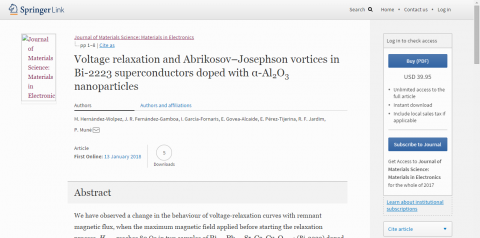
Last Friday, the Journal of Materials Science: Materials in Electronics, published the first scientific article whose main results were obtained in the Physical Characterization Laboratory equipped by the VLIR program for the development of the Eastern region of Cuba.
The text "Voltage relaxation and Abrikosov-Josephson vortices in Bi-2223 superconductors doped with α-Al2O3 nanoparticles" reports a new experimental method to detect the penetration of magnetic flux into intragranular defects and regions free of grain defects (crystallites). Said breakthrough allows independent study of the dynamics of the vortices that appear in each of the aforementioned regions. It is important from both the point of view of the fundamentals of the physics of granular superconducting materials, and their practical applications.
According to Dr. Pedro Muné, the aforementioned defects are called "hidden" defects because they are difficult to detect. However, the article reports a relatively simple method of detecting them and evaluating their participation in the dissipation of the material in the presence of remaining magnetic flux.
The authors, Manuel Hernández Wolpez, José Ramón Fernández Gamboa, are Msc and PhD. students trained by Professor Dr. Pedro Muné Bandera, while Dr. Iván García-Fornaris, Dr. Ernesto Govea Alcaide, Dr. Eduardo Pérez Tijerina, and Dr. Renato de Figauiredo Jardim, are professors from: Universidad de Granma, Cuba; Federal University of Amazonas, Brazil; Instituto de Monterrey, Mexico, and the University of Sao Paulo, Brazil, respectively.
The Physical Characterization Laboratory, located in the Faculty of Natural and Exact Sciences, has the necessary equipment for resistivity vs. temperature measurements, magneto-resistance and I-V curves for different types of materials. In addition, the microstructural characterization of steel bars can be carried out by means of the Barkhausen noise and making quality evaluations for industrial uses.
Upon knowing the acceptance of this material by the scientific committee of the journal, Dr. Hichem Sahli, Flemish leader of the VLIR IUC, sent an email to all the scientific leaders of the program in which he refers: "this is certainly good news to start the year with".
According to Dr. Pedro Munè Bandera, another article whose measurements were also developed in the Physical Characterization Laboratory is currently in process.
For more than 10 years, publications in the area of materials sciences of the Department of Physics of the UO, were conducted with experimental data obtained thanks to the collaboration with other Cuban or foreign universities, due to the degree of obsolescence of the experimental facilities for the research of the Department. This first scientific research and its international publication constitutes an endorsement of the quality of the experimental facilities created by the researchers of the VLIR IUC Oriente program.
The Journal of Materials Science: Materials in Electronics publishes scientific articles about materials and their applications in modern electronics, covering the field between fundamental science, such as semiconductor physics, and work specifically related to applications. It explores the growth and preparation of new materials, as well as their processing, fabrication, joining and encapsulation, together with reliability, failure analysis, quality assurance and characterization, related to the full range of applications in electronics.
Below you can read this material:Voltage relaxation and Abrikosov–Josephson vortices in Bi-2223 superconductors doped with α-Al2O3nanoparticles
Translator: Lilia Sanz Gámez

